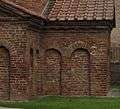Lesene
A lesene, also called a pilaster strip,[1] is an architectural term for a narrow, low-relief, vertical pillar in a wall. It resembles a pilaster, but does not have a base or capital.[2] It is typical in Lombardic and Rijnlandish architectural building styles.[3]

Lesenes, corner lesenes and arch frieze on the tower of Old St. Martin, Kaarst
Function
Lesenes are used in architecture to vertically divide a facade or other wall surface optically, albeit—unlike pilasters—without a base or capital. Their function is ornamental, not just to decorate the plain surface of a wall but, in the case of corner lesenes, to emphasise the edges of a building.
Gallery
 Lesenes and corbel table on a chapel wall
Lesenes and corbel table on a chapel wall Lesenes and corbel table at the Mausoleum of Galla Placidia in Ravenna (ca. 430 AD)
Lesenes and corbel table at the Mausoleum of Galla Placidia in Ravenna (ca. 430 AD) Lesene on the staircase tower of the Gernrode collegiate church (before 1000 AD)
Lesene on the staircase tower of the Gernrode collegiate church (before 1000 AD) Lesenes on the Abbey church of Maria Laach (1156)
Lesenes on the Abbey church of Maria Laach (1156) Lesenes on the tower of All Saints' Church, Earls Barton (Late 10th century)
Lesenes on the tower of All Saints' Church, Earls Barton (Late 10th century)
- Modern and post-modern

 Lesenes at Chile House, Hamburg
Lesenes at Chile House, Hamburg
gollark: I just download everything from the AUR.
gollark: I think you can run Linux on them nowadays, but I don't know if you get things like "functional GPUs".
gollark: I mean, on the one hand Apple's CPUs have excellent performance-per-watt, but on the other hand you are buying into what's sort of kind of a highly closed platform.
gollark: How bad.
gollark: Ah, so my Postgres instance contains data from deadosmarksmatrixserver™, Gitea, Grafana, my RSS reader, an old Minoteaur instance, and various failed osmarksßprojects™.
References
- Glossary of Medieval Art and Architecture
- Curl, James Stevens (2006). Oxford Dictionary of Architecture and Landscape Architecture, 2nd ed., OUP, Oxford and New York, p. 442. ISBN 978-0-19-860678-9.
- Mulder, Koen (2016). Het Zinderend Oppervlak [The Thrilling Surface] (in Dutch) (2nd ed.) (published January 2016). p. 157. ISBN 978-90-824668-0-5.
This article is issued from Wikipedia. The text is licensed under Creative Commons - Attribution - Sharealike. Additional terms may apply for the media files.